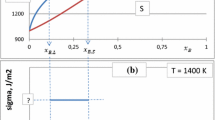Abstract
Diffusion and solution phenomena of heterogeneous atomics in binary metallic liquid/solid interface has a very wide range of applications in materials engineering, the structures and properties of the diffusion-solution zone play an important influence on the final product quality. Therefore, the study of the formation mechanism of the new intermetallic phases in interface, and prediction and control of the structure of the diffusion-solution zone have very important theoretical and practical significance. According to the heat treatment experimental results of Al/Fe, Al/Ni, Al/Ti liquid/solid interfaces, the formation mechanism of intermetallic compounds in binary metallic liquid/solid interface was analyzed. Moreover, the cohesive energy and formation heat of stable intermetallic compounds at room temperature in Al-Fe, Al-Ni, and Al-Ti binary system were calculated based on the empirical electron theory of solids and molecules, and the prediction criterion of new phase’s formation order in interface was given. Predicted results of new phase’s formation order in Al/Fe, Al/Ni, and Al/Ti liquid/solid interfaces based on the criterion agree well with the experimental results.
Similar content being viewed by others
References
LI S.C., Diffusion-Solution Zone at Phase Boundary—Super Plasticity of Zn-Al Eutectic Alloy, China University of Petroleum Press, Dongying, 2006: 1.
He K.S., and Cao X.F., Dissimilar Metal Connections, Mechanical Industry Press, Beijing, 1986. 106.
Lee B.J., Hwang N.M., and Lee H.M., Prediction of interface reaction products between Cu and various solder alloys by thermodynamic calculation, Acta Material, 1997, 45(5): 1867.
Choi W.K., and Lee H.M., Prediction of primary intermetallic compound formation during interfacial reaction between Sn-based solder and Ni substrate, Scripta Materialia, 2002, 46(11): 777.
Chen S., Liu Z.G., and Chen T.Q., Interdiffusion characteristics of Au / Sn interface, Chin. J. Rare Met., 2005, 29(4): 413.
He P., Feng J.C., and Qian Y.Y., Formation mechanism of new Intermetallic phase at diffusion bonding joints, Chinese Welding Journal, 2001, 22(1): 53.
YU R.H., Empirical electron theory in solids and molecules, Chinese Science Bulletin, 1978, 23(4): 217.
Jiang S.Y., and Li S.C., Diffusion solution zones of Al-Fe liquid/solid interfaces, Chinese Journal of Materials Engineering, 2009, SAMPE Beijing Chapter: 236.
Jiang S.Y., and Li S.C., Microstructure evolution and forming mechanism of Ni-Al solid/liquid diffusion couples, Chinese Journal of Nonferrous Metals, 2010, 20(8): 743.
Zhou G.S., Wu A.P., Reng J.L., Yang J., Liang C.J., and Li X.N., Bonding ceramics with Al/Ti/Al multilayer by in situ formation of intermetallic compound, Chinese Rare Metal Materials and Engineering, 2003, 32(12): 981.
Bouche K., Barbier F., and Coulet A, Intermetallic compound layer growth between solid iron and molten aluminum, Materials Science and Engineering, 1998, A249: 167.
Zhang R.L., Empirical Electron Theory of Solid and Molecules, Jilin Science and Technology Press, Changchun, 1993: 324.
Xu W.D., Zhang R.L., and Yu R.H., Calculation cohesive energy of transition metal compounds, Science in China, 1988, 18(3): 323.
Chen S L, Gu Q, and Wang T M, Constants of the intermetallic compounds Co3Ti and CoTi and their brittleness, Acta Physica Sinica, 1995, 44(6): 936.
Jiang S.Y., and Li S.C., Calculation of the valence electron structures and cohesive energies of intermetallic compounds in Au-Cu system, Chinese Journal of Nonferrous Metals, 2010, 20(4): 743.
Zhang Y.G., Han Y.F., and Cheng G.L., Intermetallic Compound Structure Material, National Defense Industry Press, Beijing, 2001: 551.
Wang C.M., Sun H.F., Wan D.M., and Yu M.J., Fe-Al intermetallic compound coating prepared by high temperature diffusion, Chinese Materials Protection, 2003, 36(3): 35.
López G.A., Sommadossi S., Zieba P., Gust W., and Mittemeijer E.J., Kinetic behavior of diffusion-soldered Ni/Al/Ni Interconnections, Materials Chemistry and Physics, 2003: 78(2): 459.
Wang H.B., Han J.C., Zhang X.H., and Du S.Y., Reaction mechanism of continually heating Ni and Al particles, Acta Metal Journal, 1998, 34(9): 992.
Wu Y.J., and Lan T., Study on infiltration combustion synthesis (ICS) of TiAl intermetallic compound, Chinese Rare Metal Materials and Engineering, 1996, 25(2): 17.
Goda D.J., Richards N.L., Caley W.F., and Chaturvedi M.C., The effect of processing variables on the structure and chemistry of Ti-aluminide based LMCS, Materials Science and Engineering A, 2002, 334(1–2): 280.
Li Z.Q., Han J.C., Hao X.D., and Zhang X.H., Reaction mechanism of combustion synthesis of gamma titanium aluminide, Chinese Rare Metal Materials and Engineering, 2002, 31(1): 4.
Luo J.G, and Acoff V.L. Using cold roll bonding and annealing to process Ti/Al multi-layered composites from elemental foils, Materials Science and Engineering A, 2004, 397(1–2): 167.
Author information
Authors and Affiliations
Corresponding author
Rights and permissions
About this article
Cite this article
Jiang, S., Li, S. Formation mechanism and prediction of new phases in binary metallic liquid/solid interface. Rare Metals 30 (Suppl 1), 486–491 (2011). https://doi.org/10.1007/s12598-011-0330-5
Received:
Revised:
Accepted:
Published:
Issue Date:
DOI: https://doi.org/10.1007/s12598-011-0330-5




